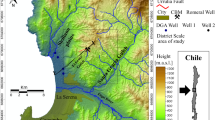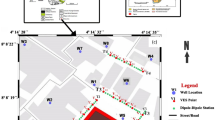Abstract
Well-developed karst aquifers tend to be heterogeneous and consist of variable porosities. Groundwater monitoring and the associated data interpretations in such aquifers are often more complicated than porous medium aquifers. Collection of representative data in karst aquifers often requires monitoring at appropriately located wells and/or springs that are proven to connect to the groundwater system. Water samples are to be collected under different flow conditions, including base flow, high-flow, and low-flow. The sampling frequencies may vary from several months for base flows to minutes in response to recharge events. The groundwater monitoring program presented in this paper is for a cement kiln dust mono-fill site in a karst area of southern Indiana. Following dye tracing and extensive geophysical investigations, one spring was selected as a monitoring location. A second spring should be used as a monitoring location when the last cell of the mono-fill begins receiving the wastes. The paper discusses results from the first spring, at which nine background sampling events were completed to evaluate the natural variations of the water quality. Based on the background data, a statistical evaluation plan was developed for 12 water-quality parameters to determine the integrity of the landfill. The statistical power of the statistical analyses was evaluated by Monte Carlo simulations.




Similar content being viewed by others
References
ASTM (1998) ASTM D 6312-98, Standard guide for developing appropriate statistical approaches for ground-water detection monitoring programs. Annual book of standards, West Conshohocken, PA, pp 1–14
Barnett V, Lewis T (1998) Outliers in statistical data. Wiley series in probability and mathematical statistics, 3rd edn. Wiley, West Sussex, England, p 584
Barrett ME, Zuber RD, Collins ER, Malina JF Jr, Charbeneau RJ (1993) A review and evaluation of literature pertaining to the quantity and control of highway runoff and construction. Technical Report CRWR 239, 1st edn. Center for Research in Water Resources, University of Texas, Austin, TX
Brooke D, Evans DA (1972) An approach to the probability distribution of CUSUM run length. Biometrika 59:539–549
Davis CB (1998) Power comparisons for control chart and prediction limits procedures. EnviroStat Technical Report 98-1. Environmetrics & Statistics Limited, Henderson, NV
Drever JI (1997) The Geochemistry of natural waters, 3rd edn. Prentice-Hall, Upper Saddle River, NJ, p 436
Dreybrodt W (1988) Processes in Karst Systems—Physics, Chemistry, and Geology. Springer Series in Physical Environment. Springer-Verlag, Germany
Field MS (2002) The QTRACER2 program for tracer-breakthrough curve analysis for tracer tests in karstic aquifers and other hydrologic systems. EPA/600/R-02/001
Gibbons RD (1994) Statistical methods for groundwater monitoring. Wiley Inc., New York
Gibbons RD (1999) Use of combined Shewhart-CUSUM control charts for ground water monitoring application. Ground Water 37(5):682–691
Gibbons RD, Coleman DE (2001) Statistical methods for detection and quantification of environmental contamination. Wiley Inc., New York
Helsel DR, Hirsch RM (2002) Statistical methods in water resources. Techniques of Water-resources investigations of the United States geological survey, book 4, hydrologic analysis and interpretation, Chap. 3. US Geological Survey, Reston, VA
Lounsbury RA, Pettit AJ, Zhou W, Beck BF (2003) Effective practices for initiating high-frequency, storm-induced sampling of two karst springs. In: Beck BF (ed) Sinkholes and engineering/environmental impacts of Karst. Geotechnical special publication #122, American society of civil engineers, Reston, VA, pp 328–338
Lucas JM, Crosier RB (1982) Robust CUSUM: a robustness study for CUSUM quality control schemes. Communications in statistics. Theor Method 11(23):2669–2687
Lucas JM (1982) Combined Shewhart-CUSUM quality control scheme. J Qual Technol 14:51–59
Lucas JM (1985) Cumulative Sum (CUSUM) control schemes. Communications in statistics. Theor Method 14(11):2689–2704
Millard SP, Neerchal NK (2000) Environmental statistics. CRC Press, Boca Raton, FL
Parkhurst DF (1998) Arithmetic versus geometric means for environmental data. Environ Sci Technol/News, Feb. 1, 92A–98A
Quinlan JF, Smart PL, Schindel GM, Alexander EC Jr, Edwards AJ, Smith AR (1991) Recommended administrative/regulatory definition of karst aquifer, principles for classification of vulnerability of karst aquifers, and determination of optimum sampling frequency at springs. In: Proceedings of the 3rd conference on hydrogeology, ecology, monitoring, and management of ground water in karst terranes. Nashville, TN, 4–6 December
Ryan TP (2002) Statistical methods for quality improvement, 2nd edn. Wiley, New York, p 446
Smart CC (1999) Subsidiary conduit system: a hiatus in aquifer monitoring and modeling. In: Palmer AN, Palmer MV, Sasowsky ID (eds) Karst modeling. Special publication 5. Karst Water Institute, Charles Town, WV, pp 146–157
Starks TH (1988) Evaluation of control chart methodologies for RCRA waste sites. Draft Report by Environmental Research Center, University of Nevada, Las Vegas, for Exposure Assessment Research Division. Environmental Monitoring Systems Laboratory—Las Vegas, Nevada. EPA Technical Report CR814342-01-3
Tasker GD, Granato GE (2000) Statistical approaches to interpretation of local, regional, and national highway-runoff and urban-stormwater data. Open-File Report 00–491. US Geological Survey, VA
USEPA (1998) Draft technical background document on groundwater controls at CKD Landfills. Office of solid wastes, US Environmental Protection Agency, Washington, DC
USEPA (1989) Statistical analysis of ground-water monitoring data at RCRA Facilities. Interim Final Guidance. EPA/530-SW-89-026, Office of solid waste, US Environmental Protection Agency, Washington, DC
USEPA (1992) Statistical analysis of ground-water monitoring data at RCRA Facilities: addendum to interim final guidance, in statistical training course for ground-water monitoring data analysis. EPA530-R-93-003, Washington, DC
Zhou W, Beck BF, Stephenson JB (1999) Application of electrical resistivity tomography and natural-potential technology to delineate potential sinkhole collapse areas in a covered karst terrane. In: Beck BF, Pettit AJ, Herring JG (eds) Hydrogeology and engineering geology of sinkholes and karst. A. A. Balkema, Rotterdam, pp 187–193
Zhou W, Beck BF, Pettit AJ, Stephenson JB (2002) A groundwater tracing investigation as an aid of locating groundwater monitoring stations on the Mitchell Plain of Southern Indiana. Environ Geol 41:842–851
Acknowledgments
The authors wish to thank the following people who participated in the project and contributed to its success at various stages: Brad J. Stephenson of Shaw Groups, Rich A. Lounsbury of AMEC, David Parkhurst of Indiana University, Joseph Woods of Indiana Department of Environmental Management, Angela L. Adams of MACTEC, Gheorghe Ponta and Desiree Sturdivant of P. E. LaMoreaux and Associates, Inc.
Author information
Authors and Affiliations
Corresponding author
Rights and permissions
About this article
Cite this article
Zhou, W., Beck, B.F., Wang, J. et al. Groundwater monitoring for cement kiln dust disposal units in karst aquifers. Environ Geol 52, 761–777 (2007). https://doi.org/10.1007/s00254-006-0514-8
Received:
Accepted:
Published:
Issue Date:
DOI: https://doi.org/10.1007/s00254-006-0514-8




